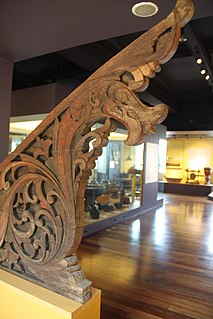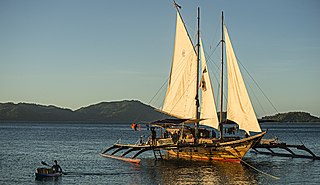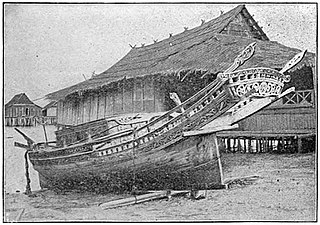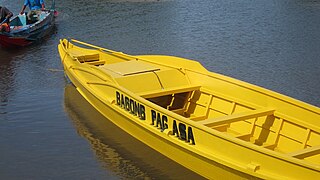
Okir or okil is the term for rectilinear and curvilinear plant-based designs and folk motifs that can be usually found among the Moro and Lumad people of the Southern Philippines, as well as parts of Sabah. It is particularly associated with the artwork of the Maranao and Sama (Badjao) tribes, although it can also be found to a lesser extent among the Maguindanao, Iranun, Tausug, Yakan, and Lumad groups. The design elements vary among these ethnic groups, with the greatest refinement being found among the Maranao.

The Sama-Bajau refers to several Austronesian ethnic groups of Maritime Southeast Asia. The name collectively refers to related people who usually call themselves the Sama or Samah ; or are known by the exonym Bajau. They usually live a seaborne lifestyle and use small wooden sailing vessels such as the perahu, djenging (balutu), lepa, and vinta (pilang). Some Sama-Bajau groups native to Sabah are also known for their traditional horse culture.

Banguingui, also known as Sama Banguingui or Samal Banguingui is a distinct ethno-linguistic group native to Balanguingui Island but also dispersed throughout the Greater Sulu Archipelago and southern and western coastal regions of the Zamboanga Peninsula in Mindanao, Philippines. They are one of the ethnic groups usually collectively known as the Sama-Bajau peoples.

The vinta is a traditional outrigger boat from the Philippine island of Mindanao. The boats are made by Sama-Bajau, Tausug and Yakan peoples living in the Sulu Archipelago, Zamboanga peninsula, and southern Mindanao. Vinta are characterized by their colorful rectangular lug sails (bukay) and bifurcated prows and sterns, which resemble the gaping mouth of a crocodile. Vinta are used as fishing vessels, cargo ships, and houseboats. Smaller undecorated versions of the vinta used for fishing are known as tondaan.

Pangalay is the traditional "fingernail" dance of the Tausūg people of the Sulu Archipelago and eastern coast Bajau of Sabah.

Balangay, also spelled barangay, is a type of lashed-lug boat built by joining planks edge-to-edge using pins, dowels, and fiber lashings. They are found throughout the Philippines and were used largely as trading ships up until the colonial era. The oldest known balangay are the Butuan boats, which have been carbon-dated to 320 AD and were recovered from several sites in Butuan, Agusan del Norte.
Bajaw is the language of the Bajaw, widely known as the 'sea gypsies' of Maritime Southeast Asia. Differences exist between the language's varieties in western Sabah, Mapun in southern Philippines, eastern Sabah, and across Sulawesi to Maluku.

The Sama language, Sinama, is the language of Sama-Bajau people of the Sulu Archipelago, Philippines; Sabah, Malaysia and parts of Indonesia. The Sama are one of the most widely dispersed peoples in Southeast Asia.

Panguan Island is an island in the municipality of Sitangkai, Tawi-Tawi. With an area of 0.06 square kilometres (0.023 sq mi). It is also known as Malamanok, coming from the Sama-Bajau dialect which means eat chicken as locals who travel to Sabah usually use this island as a stop-over to eat roasted chicken prior continuing their journey to Malaysia. It is the last island of the Sulu Archipelago nearest to the Philippine-Malaysian border.

Lepa, also known as lipa or lepa-lepa, are indigenous ships of the Sama-Bajau people in the Philippines and Malaysia. They were traditionally used as houseboats by the seagoing Sama Dilaut. Since most Sama have abandoned exclusive sea-living, modern lepa are instead used as fishing boats and cargo vessels.

Buggoh is a type of small dugout canoe of the Sama-Bajau people of the Philippines. They are made from a single log hollowed into a canoe with a rounded bottom. It is equal-ended, with the prow and the stern dropping straight down or sloping outward. They are sometimes equipped with two outrigger floats. They are usually around 1.5 to 4.5 m long. It is also known by various other names, including boggo', buggoh jungalan, buggoh-buggoh, or beggong.

Bangka are various native watercraft of the Philippines. It originally referred to small double-outrigger dugout canoes used in rivers and shallow coastal waters, but since the 18th century, it has expanded to include larger lashed-lug ships, with or without outriggers. Though the term used is the same throughout the Philippines, "bangka" can refer to a very diverse range of boats specific to different regions. Bangka was also spelled as banca, panca, or panga in Spanish. It is also known archaically as sakayan.

Tataya are traditional small fishing boats, with or without outriggers of the Ivatan people in the Philippines. They are generally round-hulled and powered by rowers or sails made from woven pandanus leaves. They have several variants based on size and island of origin. The term tataya can also be used for all traditional boats in the Batanes Islands in general, similar to the term bangka in the rest of the Philippines.

Djenging is a type of large double-outrigger plank boat built by the Sama-Bajau people of the Philippines. It is typically used as a houseboat, though it can be converted to a sailing ship. It was the original type of houseboat used by the Sama-Bajau before it was largely replaced by the lepa after World War II. Larger versions of djenging were also known as balutu or kubu, often elaborately carved with bifurcated extensions on the prow and stern.

Junkun, is a type of small dugout canoe of the Sama-Bajau people of the Philippines. They are usually made from a single log, though a single plank can be added to the sides, and longer boats can include ribs that support a deck made of planks. They are around 2.5 to 8 m long. They have knob-like protrusions on the tip of the prow and the stern, which also sweep upwards from the waterline. They are sometimes equipped with double outriggers. They are used for fishing and short-distance travel.
Ontang is a type of raft of the Sama-Bajau people of the Philippines. They resemble a miniature catamaran, with two bamboo floats about 1 m (3.3 ft) long connected by two bow-shaped booms. A platform made split bamboo is built on top of the booms. Ontang can be used for fishing, but they can also hold lanterns during night-time fishing. They are typically towed behind Sama-Bajau houseboats during travel, with the towing line commonly strung with baited fish hooks.
Bangka anak-anak are very small dugout canoes among the Sama-Bajau people of the Philippines. They are typically made by Sama-Bajau fathers for their children and are patterned after the larger Sama-Bajau dugout canoes. They can be used for transportation between the Sama-Bajau houseboats, but are more commonly used for playing. They are typically no longer than around 1.5 m (4.9 ft) long. Children as young as three or four can use these boats, which allows them to learn valuable maritime skills.

Tiririt, also known as taririt or papet, is a type of small dinghy of the Sama-Bajau and Tausug people of the Philippines. It is commonly motorized. It is usually carried aboard larger motherships and assists in transporting passenger and cargo to the shore, as well as in towing the boat to port. However, it can also be used as a small inter-island transport. It is roughly leaf-shaped in outline with a distinctive hump-backed side-profile. The prow and stern can sometimes rise up into arcs. It normally has no outriggers.




















